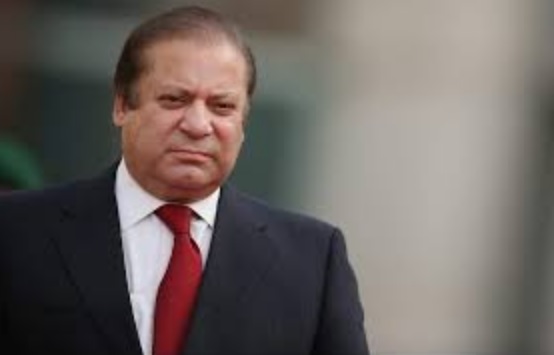
Pakistan elections: New Delhi’s perspective on Army backing Nawaz Sharif
South Block views the replacement of the Army Chief as the true shift of power in Pakistan, unlike democracies where elections ensure peaceful transitions.
The 12th national general elections in Pakistan are scheduled for Thursday, with approximately 12.85 crore eligible voters, roughly half of the country’s population of 24.1 crore, poised to cast ballots to elect a new National Assembly and four provincial legislatures.
Two hundred and sixty-six National Assembly members will be elected through a first-past-the-post system akin to India’s. Additionally, sixty seats are earmarked for women and ten for non-Muslims, to be allocated to parties based on their proportionate share of directly elected seats.
From India’s viewpoint, Pakistani elections revolve around the dynamics of power balance between the civilian administration and the military.
South Block views the replacement of the Army Chief as the true transfer of power in Pakistan, unlike in democracies where peaceful transitions result from elections.
The military wields significant influence in Pakistani politics, often perceived as influencing elections to ensure victory for their preferred candidate. In the 2018 elections, the Army “selected” cricket legend-turned-politician Imran Khan to replace Nawaz Sharif, the leader of the PML(N). Imran assumed the Prime Minister’s role after Nawaz’s conviction, although Nawaz was permitted to depart the country.
Six years later, Imran, aged 71, finds himself behind bars, serving a 14-year sentence for involvement in an illegal gifts case and a 10-year term for divulging classified information. His absence has become the focal point of the upcoming elections.
Imran’s arrest in May 2023 triggered protests from his Pakistan Tehreek-e-Insaf (PTI) party supporters. Demonstrators breached and vandalized several military installations, including the residence of a high-ranking general. In the subsequent stringent crackdown, hundreds of PTI members, including Imran’s deputy and former Foreign Minister Shah Mahmood Qureshi, were detained, and numerous leaders faced intimidation tactics.

Imran has been abandoned by a faction of his party, with figures like Jahangir Tareen and others establishing their own party under the approval of the Army.
Once more, the Army’s favored candidate is Nawaz Sharif, the 74-year-old three-time Prime Minister who made a return to Pakistan in October following the removal of obstacles. Nawaz has faced opposition from the Army on two previous occasions — first in 1999 when Gen Pervez Musharraf staged a coup against him, and later in 2017 when he fell out of favor and was compelled to resign.
His reputation for being pro-business, his cooperative stance towards India and the United States, and the effective governance of his brother Shehbaz Sharif — who served as Prime Minister until last August when caretaker PM Anwaar-ul-Haq Kakar assumed office — have reinstated his favor with the Army.
Zardari, still ambitious
Asif Ali Zardari aims to reclaim the presidency, while his son, Bilawal Bhutto Zardari — who served as Foreign Minister in the PML(N)-PPP coalition government following Imran’s tenure, under Shehbaz Sharif — aspires to become Prime Minister. However, the PPP’s influence has waned since the time when Zardari’s wife, Benazir Bhutto, captivated the nation both in life and in her demise, with its support base now reportedly confined to Sindh.
No level playing field
Analysts have consistently highlighted the lack of a fair electoral environment in the upcoming elections, which are not anticipated to be conducted freely or fairly.
Despite Imran’s enduring popularity, his supporters have faced arrests and intimidation, with the PTI being deprived of using its election symbol, the cricket bat. Additionally, there have been instances of Imran’s candidates encountering obstacles in filing their nominations.
The “unofficial authorities” consisting of the Election Commission of Pakistan, the judiciary, and the Pakistan Army are perceived as spearheading the crackdown against Imran and his party. Previously, media outlets were instructed not to mention Imran in their reports.
The known unknowns
Punjab holds a larger voter population compared to the combined total of the other three provinces, with 7.32 crore out of 12.85 crore eligible voters. Additionally, it accounts for 141 out of the 266 general seats in the National Assembly.
Both PTI and PML(N) derive their support and popularity primarily from Punjab, although the PPP and Tareen’s Istehkam-e-Pakistan (IPP) also have a presence. Previous elections have seen narrow winning margins, sometimes as small as 1,000-2,000 votes in constituencies with an average of 9 lakh voters.
If PTI supporters show up in large numbers at polling stations, it will be more challenging for the Pakistan military to manipulate the elections. Conversely, a lower voter turnout could indicate a lack of enthusiasm among those who may feel resigned to a predetermined outcome.
Historically, turnout rates for the last four elections — in 2018, 2013, 2008, and 2002 — stood at 51%, 53%, 44%, and 41% respectively.
The youth vote holds considerable potential, with the number of voters aged between 18 and 35 totaling 5.7 crore, representing over 47% of the electorate. Imran is believed to enjoy significant support within this demographic.
The 5.9 crore registered female voters make up 46% of the total electorate. Their level of engagement and autonomy in voting patterns, potentially distinct from the men within their households, presents an intriguing aspect to observe.
Furthermore, the country’s economic landscape is notable — with a 30% inflation rate, escalating living costs, and elevated levels of unemployment and poverty. Voters are likely to take these factors into account when casting their ballots.
The view from New Delhi
From India’s standpoint, these elections are perceived as more foreseeable than ever. The military’s preference has been unmistakably stated, with some characterizing the upcoming event on February 8 as the “epitome of all selections.”
For India, the primary concern revolves around Pakistan’s persistent backing of terrorism, and it has largely embraced a policy of apathy as its western neighbor grapples with escalating challenges on various fronts. However, the elections could potentially present a chance for a new beginning.
For the first time in several years, the election schedules of both countries have synchronized. By May, India will have a government with a five-year tenure, while Pakistan’s civilian administration will be relatively new, having been in office for a few months. General Asim Munir assumed office as Army Chief in November 2022, and considering his predecessor’s six-year tenure, it will be some time before there is a transition of leadership at the GHQ in Rawalpindi.
This presents an opportunity for both sides to consider long-term perspectives in their complex relationship.


